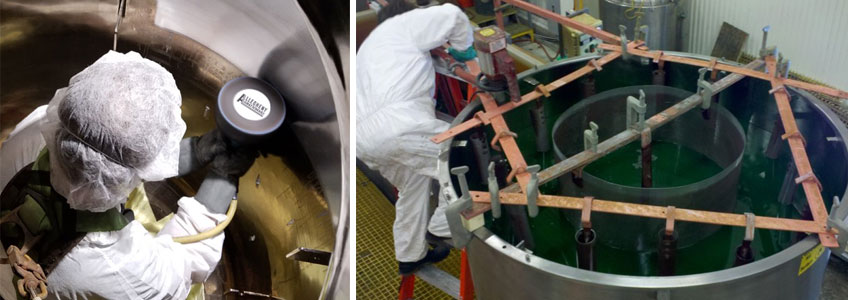Mechanical Polishing vs Electropolishing

What is Mechanical Polishing?
Mechanical polishing is the mechanical smoothing and removal of contaminants. It involves grinding, polishing and buffing of the surface. This process is used to smooth welds, prepare metal for surface treatments like electropolishing or provide a surface with a specified roughness.
What is Electropolishing?
Electropolishing is an electrochemical process that smooths the surface by removing the peaks on a nanoscopic level (anodic leveling). This enhances the corrosion resistance of austenitic stainless steels. And in some applications also reduces product adhesion and contamination buildup. Electropolishing may also be used for deburring and dulling sharp edges. The result is often a lustrous and reflective finish.
What is the difference between Mechanical Polishing and Electropolishing?
The differences between electropolishing and mechanical polishing may not be obvious to the unaided human eye, particularly if both surfaces are polished to the same micro-inch surface finish. The merits of electropolished surfaces become apparent, however, when viewed under high magnification.
Unlike electropolishing, mechanical polishing can distort the surface, leaving smears, cavities and torn metal. These cracks and crevices are huge contamination traps which limit the overall cleanability of a metal surface. These imperfections are often beyond the reach of aggressive ultra-cleansing applications. Even very fine mechanical polishing or buffing produce an abundance of scratches and strains in the metal surface. Moreover, a host of microscopic debris and abrasives can become embedded in the surface of mechanically polished metals.
| Mechanical Polishing | Electropolishing |
| Smooth with abrasives | Smooth by anodic leveling |
| May increase product adhesion depending upon final grit size | Reduces product adhesion |
| May require more intensive cleaning process | Increases cleanability |
| High luster possible after labor intensive processing | High luster and reflectability typical in most stainless steel materials |
| Metal surface distortion is possible | Reveals the original crystal structure of the metal surface without distortion |
| May create microscopic scratches, stain the surface, embed abrasive residue | Completely smooths the metal surface and removes any contamination |
| High luster may require days to achieve | High luster often achieved in minutes |
So why use one process over the other?
In many cases, electropolishing is best used to compliment mechanical polishing. Electropolishing operates in the micro range, smoothing and leveling defects to a few thousandths of an inch in depth. Larger defects may never be removed by electropolishing, warranting a mechanical prefinishing step to the complete process.
Electropolishing may improve the Ra value of a part by up to 50 percent. To lower the Ra finish, you may need to add mechanical pre-polishing before moving on to microfinishing with electropolishing.
Allegheny Surface Technology (AST) employs experienced and highly skilled craftsmen who have the training to perform this service at any facility. Our state of the art polishing facility and equipment enable us to consistently achieve your surface finishing requirements, as fine as single digit Ra readings with proper prefinshing. We are able to work on OEM parts as well as refurbish used vessels and equipment in our shop and customer locations with our field service technicians.
Allegheny Surface Technology is your trusted provider of high-performance, ASTM and BPE compliant electropolishing, pickling, mechanical polishing, and passivation services. Specializing in both in-house and on-site stainless steel surface refinishing/refurbishment services, AST assures both the quality and reliability of our services through multi-step Quality Assurance and inspection protocols.
